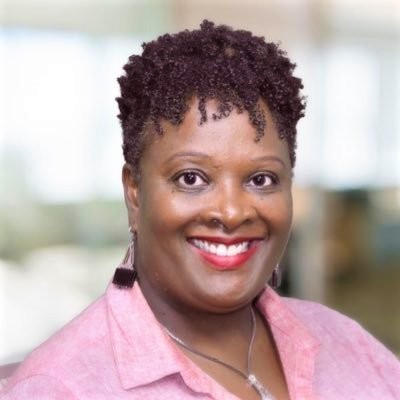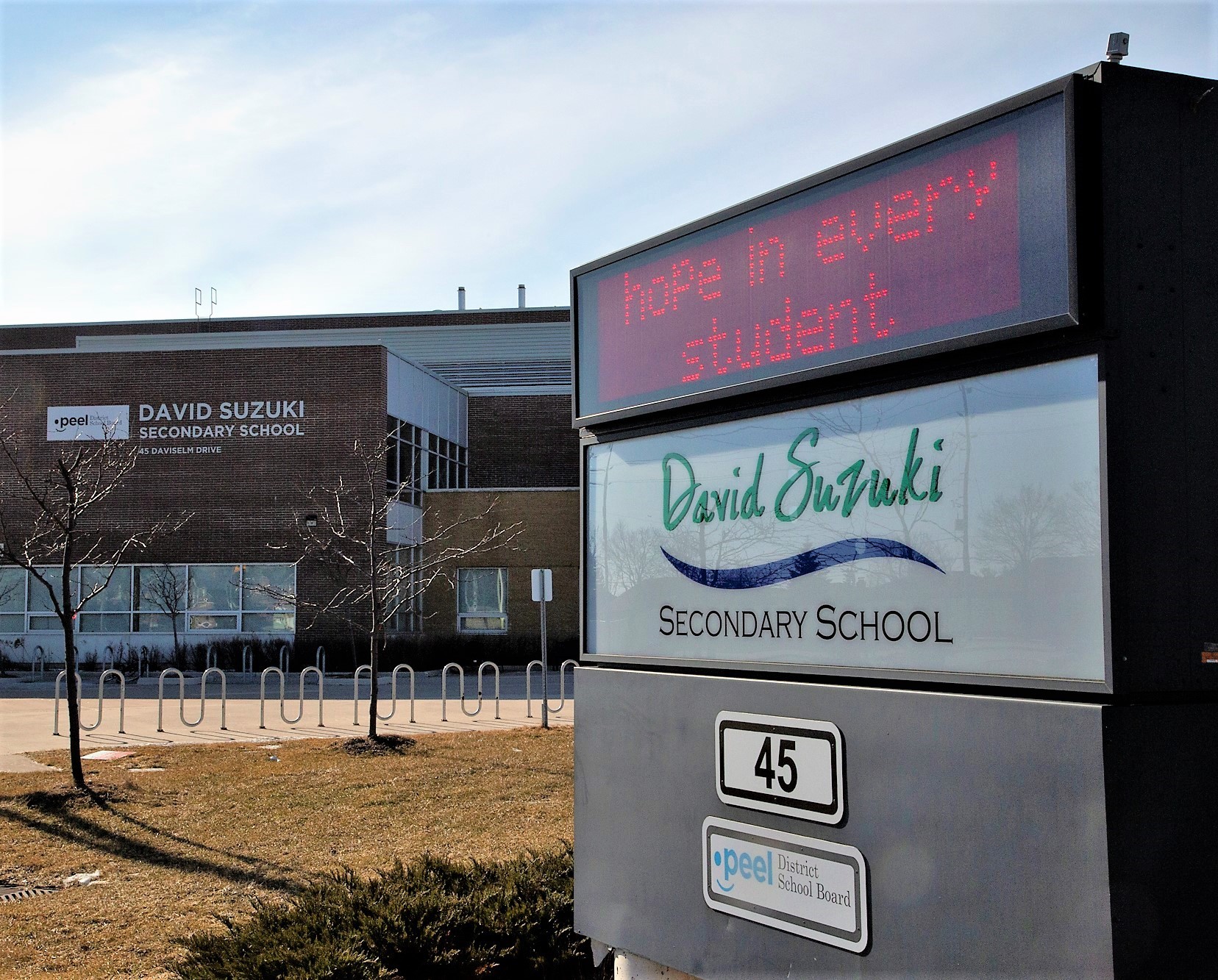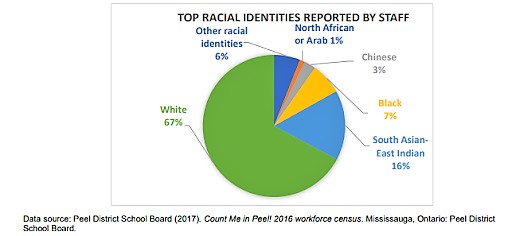
PCs take bold initial step to finally diversify the colour of teaching in Ontario
In 2010, Simmi Jaswal graduated as a fully qualified teacher. It was the textbook example of a dream coming true.
“I was very one-track minded about what I wanted to be doing,” she tells The Pointer. Even before completing Teachers’ College, she helped out at her high school, making lesson plans and educating students as a volunteer. She just wanted to make a positive difference in the lives of young people.
But something strange happened.
Despite her enthusiasm, well rounded resumé and glowing credentials, the Punjabi-Canadian educator found doors being shut in her face. It took five years after her graduation to secure a temporary teaching position with the Peel District School Board (PDSB) and a further four for her to make the permanent list.

Peel educator Simmi Jaswal says she faced barriers trying to break into the teaching ranks
Her white classmates, she says, did not face the same protracted and tenuous career path.
It's a common story of roadblocks many visible minority educators in Peel encounter. Despite living in a region where the majority of residents are racialized, teachers remain overwhelmingly white. At PDSB, the second largest school board in Ontario, 67 percent of staff (mostly made up of teachers) are white and almost 84 percent of students are non-white.
Many, including Education Minister Stephen Lecce, have linked this unrepresentative workforce to Regulation 274, a rule preferring seniority over all else in the hiring process. It demands long-term occasional (LTO) and new permanent teaching positions be created by interviewing from a pool of the top five most senior supply teachers applying, rather than casting a wide net based on credentials (which could include lived experience). It favours tenure over merit and acts as an entry-level bottleneck at the point where younger, more diverse teachers trying to inject themselves into the system are often excluded in favour of older educators.
The main teachers’ unions in Ontario including the ETFO and OSSTF, representing elementary and secondary school educators, have adamantly supported Regulation 274, claiming it does not hinder diversity.
The numbers and reams of accounts by young teachers such as Jaswal contradict the claims of unions.
This contractual clause was introduced in 2012 after pressure from the Ontario English Catholic Teachers' Association (OECTA) to deal with nepotism at smaller school boards. Since its inception, it has been fiercely defended by the teachers’ unions and has meant slow changes to the makeup of educators in Ontario.
Young, diverse teachers face further delays when trying to reach their ultimate goal of securing permanent, full-time teaching jobs, while older, mostly white teachers enjoy all sorts of advantages. They are allowed to teach 50 days a year as supply teachers to supplement their income even after they retire without affecting their pension (seeing retired teachers in the classrooms of their old schools earning two sources of income is a common sight across the province, which prevents young teachers who can’t even find one source of income from being hired).
Hiring under 274 favours length of time served over merits such as educational background, language skills and cultural competency. Even former Liberal premier Kathleen Wynne, who has a Master of Education degree and oversaw the creation of 274, described it as an “overcorrection”.
On Thursday, Lecce announced the Province would be reversing the rule, a move that will allow school boards to hire faster and more equitably in the face of the COVID-19 pandemic.

Education Minister Stephen Lecce, in Vaughan Thursday, has not outlined a clear plan to replace Reg. 274 and ensure better equity
“For nearly a decade, Ontario has hired educators based on seniority. It did not serve our students well, in fact it undermined the quality of teaching,” Lecce said during a virtual announcement live streamed from Vaughan. “As noted in countless studies, our teachers do not reflect the communities in which they serve. We’re not seeing the representation of qualified teachers from many backgrounds that define our province’s rich diversity.”
He specifically cited the lack of diverse representation among PDSB’s staff as a problem central to the motivation for removing Regulation 274. It’s a change that might not have much effect on one of Peel’s major school boards.
Bruce Campbell, general manager of communication for the Dufferin-Peel Catholic District School Board, explained to The Pointer the changes would not have an immediate impact on Catholic boards. “Unless the provincial government overrides the hiring practices clause within the central agreement with the Ontario English Catholic Teachers Association (OECTA), contractually, seniority-based hiring will continue, and the repeal will not be beneficial to Catholic school boards,” he said in an email. “This will continue to impact DPCDSB’s ability to attract and hire teacher candidates that represent our diverse student population and communities. These candidates will now have direct and immediate access to employment opportunities outside the Catholic school system.”
The Catholic board’s messaging represents a growing problem for the teachers’ unions: while school boards across the GTA and the education ministry under Lecce want far more progress to reflect the immense diversity among students by having teachers in front of them who can relate to their lived experience and act as positive role models, the unions, dominated by older white members, have been digging in their heels.
One of the biggest frustrations among diverse educators with the current system is seniority and experience are simply not always synonymous.
Anisa Hosein, an Indo-Caribbean educator at PDSB, said she has seen the seniority lists topped by teachers living outside the GTA or even Ontario, people teaching only when it was convenient for them, or part-timers hanging around for years. Because seniority is measured based on when someone is added to the list rather than by how much they have been teaching recently, complacent older staff, who often don’t live anywhere near the communities they work in, with only a half interest in teaching can top a list that keeps enthusiastic new recruits shut out, she says.
As young and more diverse teachers have begun to qualify in recent years, older (and predominantly white) staff have stymied their chances of advancing. The seniority associated with Regulation 274 cements the advantages of older generations.
“It is a kind of domino effect,” Hosein explained to The Pointer. A decade or two ago, she says, jobs were easier to find and many white graduates could walk into new roles, often with the help of relatives or friends already in the education system. That hangover provided them seniority over subsequent graduates, and created the current backlog.
Essentially, the education of more visible minority teachers has coincided with fewer job opportunities, with Regulation 274 compounding the problem by locking out new recruits, she says.
This is not the line unions are pumping out.
“It came into being to stop nepotism and unfair hiring practices,” Gail Bannister-Clarke, president of Peel’s ETFO local and a supporter of the regulation, told The Pointer. “I’ve actually seen how, in the previous years before we had Reg. 274, our occasional teacher list, there were many racialized members who said they had challenges … being hired [from the list for a full-time position].”

Gail Bannister-Clarke, president of Peel’s ETFO local, said she's surprised many younger members didn't support Reg. 274
When asked about concerns around 274, Bannister-Clarke expressed her support for reforming the regulation, but said she felt the ministry did not have a plan in place to force equity. She said she was “surprised” some young educators were frustrated by the rule.
The ministry says it will provide some guidance for a new approach but will leave it up to local boards to determine how equitable hiring will be shaped in the future, under the Province’s guidelines.
“When you look at teacher colleges … most of the programs have maybe one or two Black teachers in them… that’s a huge issue,” she said. “We need to be working together [with Queen’s Park]. We need experts to come together to look at data to develop a plan that will work.”
Bannister-Clarke’s support of the regulation (in absence of an alternative) is in line with her union, which tweeted accusing Lecce of “spinning myths about hiring to drive through a Conservative agenda.” The Ontario Secondary School Teachers Federation (OSSTF) has echoed this messaging. President Harvey Bischof publicly called the move a “distraction” from problems with Ontario’s back-to-school plan during the pandemic.
“I’m talking about the political perspective the Minister takes to this,” he explained to The Pointer. “Addressing anti-Black racism, addressing discrimination in any form has got to be considered as equal priority [to COVID-19]. We’ve seen that these things can’t be disentangled.”
The Pointer asked Bischof if he would support the ending of Regulation 274 on condition the Ministry of Education replaced it with a policy that demonstrably improves the position of visible minority educators. He agreed, saying he and his members would back its removal under those conditions.
“We’ve tried so many times to engage in constructive dialogue with the minister and we have been rebuffed every time,” he said. “Why not come up with an excellent replacement for the regulation that is fair and promotes diversity and equity in hiring and then put it in place rather than presenting a hypothetical to replace the regulation? If they took that approach, if they consulted and came up with a regulation that supported diversity in hiring and fairness, I would be 100 percent behind that approach.”

The absence of an alternative to 274 is an issue Lecce has not directly addressed, and a new mechanism to guarantee equity and merit-based hiring has not been outlined.
“I’m with Harvey [Bischof] on that — I want to see a plan in place,” Gord Gallimore, an educator and vocal member of OSSTF Peel’s Disrupting Anti-Black Racism Advisory Committee (DABRAC) and an interim appointee to an executive, time-release position (meaning he will not work in the classroom) told The Pointer. He described a policy during a stint teaching in Nova Scotia that allowed schools with particularly diverse student populations to advertise positions specifically for Black or Indigenous staff in order to reflect the student body. “I do want to ensure it doesn’t go back to the whole nepotism ordeal,” he added, saying the union positions appointed by DABRAC would be key in negotiating an equitable replacement for 274 in Peel.
The less than cooperative stance of union leadership, which has long fought to preserve the status quo in hiring and promotional practices, is perhaps unsurprising, with the organizations built on a foundation of seniority. It has served older members well, with perqs like getting to teach for 50 days a year after retirement while collecting a handsome pension.
Individuals like Bischof, who earned $219,980 in 2019 working full time representing teachers, have risen to the top of unions and are unlikely to want to see the foundations shaken. He said the system of seniority was “by no means” always perfect, but designed to reduce personal bias.
In Peel, as The Pointer has previously reported, the local OSSTF leadership has come under fire for delays in implementing equity reforms, despite being supported overwhelmingly by members. The stance of many executive members has been a barrier to creating the diversity that is so lacking in Peel’s teaching landscape. Unions, willingly spending massive amounts on advertising campaigns around contract negotiations and public safety concerns around COVID, have been reluctant to engage in real conversations about anti-Black racism and other forms of discrimination.
They have traditionally been silent in Peel, even while issues around race and religion in one of the most diverse regions in the world have boiled over.
When Sikh students in Peel were banned from wearing the Kirpan by the PDSB more than two decades ago, unions stood with the board and against the Sikh community. They remained largely silent when the issue of Islamic prayers in Peel schools became a flashpoint and most recently, when Black communities across the region demanded action in the face of damning evidence of systemic racism by PDSB against their children, the unions once again stayed on the sidelines.
The lack of diverse teachers in the classroom was a root issue in the Province's findings of systemic anti-Black racism and other forms of widespread discrimination within PDSB. The Ministry of Education launched a sweeping investigation last year, ordered by Lecce, after shocking examples of discriminatory behaviour by PDSB educators and trustees highlighted by Black parents and community leaders could no longer be ignored.
The investigation report in March led to the firing of PDSB's leader, former director Peter Joshua, and other sweeping equity directives ordered by the Province. The Pointer also reported blatantly racist conduct by principals and the board was forced by the ministry to apologize for the "harm" it has caused to Black students.
The alarming probe documented what happens when Black and other visible minority students do not see themselves reflected or supported by administrators and teachers, who are overwhelmingly white, in a board whose student body is 84 percent non-white.

Diverse union members struggling to change these dynamics who have spoken to The Pointer are questioning why these organizations are not representing their interests despite collecting dues from them.
The stances of both Bischof and Bannister-Clarke show a slight softening and willingness to support reform.
In Peel, the decision to scrap Regulation 274 has sparked quiet optimism, but many are suspicious of any empty solutions masquerading as a panacea.
The spotlight on anti-Black racism and systemic discrimination within PDSB makes stronger the argument for removing Regulation 274. Staffing problems at the height of a global pandemic help too. The PCs under Lecce’s lead on the file have made no secret they dislike the regulation. But does removing it suit little more than their political objective, while doing little to actually solve the equity problems in hiring, so ingrained in institutions like PDSB?
The Ministry of Education says it will provide “an interim teacher hiring policy” that will offer “guidance” to boards as they develop locally tailored solutions that reflect their needs and meet standards laid out by Queen’s Park.
“The question that comes up is: are there going to be any parameters based on the demographics of hiring?” Hosein added. “If there is nothing in place like a regulation, I am concerned that this may not be reflected because then it comes down to principal hiring.”
In the past, principals have held great sway over who they want to hire and rules in Peel have often been bent by principals who find ways to get around them when looking to hire who they want. This was documented when PDSB was forced to implement The Journey Ahead program in 2013 following human rights cases, most prominently the one filed by former vice principal Ranjit Khatkur, that laid out evidence of widespread nepotism and discrimination in the board’s hiring and promotions practices. Even after the program was launched cases of principals hiring based on nepotism and bias have been reported within the board.
These types of inequities, which have traditionally advantaged the same educators union policies have also supported, are concerns raised by many, including Judy McKeown, an active member of DABRAC and another interim appointee. “I think this is something that needs to be codified, it cannot just be the removal of Regulation 274 without the express... centring of the idea of honouring people’s lived experiences as part of what needs to happen in the classroom,” she said.
All qualifications being equal, the board could give the nod to Black, South Asian, Indigenous and other teachers for permanent positions over their white counterparts to allow staff to better reflect the pupils they teach, while providing cultural awareness, specific types of mentorship and positive role modelling.
“If handled carefully, then removing that regulation could open a lot of doors, but … if there is no specific direction to address that disparity, then I don't actually think the barriers will be removed,” Jaswal said.
Email: [email protected]
Twitter: @isaaccallan
Tel: 647 561-4879
COVID-19 is impacting all Canadians. At a time when vital public information is needed by everyone, The Pointer has taken down our paywall on all stories relating to the pandemic and those of public interest to ensure every resident of Brampton and Mississauga has access to the facts. For those who are able, we encourage you to consider a subscription. This will help us report on important public interest issues the community needs to know about now more than ever. You can register for a 30-day free trial HERE. Thereafter, The Pointer will charge $10 a month and you can cancel any time right on the website. Thank you.
Submit a correction about this story


